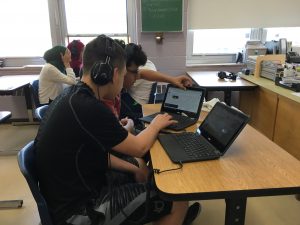Collaborative Maps, Asynchronous Learning, and Moodle Rubrics
Collaborating on Maps
 Today, students in Mr. Apple’s class at Woodworth Middle school began their next tech-integrated project for 8th Grade U. S. History: A Civil War Google My Maps group activity. Google My Maps allows students to create and collaborate on a custom map in a familiar way since My Maps works just like a Google Doc or Google Slides presentation.
Today, students in Mr. Apple’s class at Woodworth Middle school began their next tech-integrated project for 8th Grade U. S. History: A Civil War Google My Maps group activity. Google My Maps allows students to create and collaborate on a custom map in a familiar way since My Maps works just like a Google Doc or Google Slides presentation.
In this activity, students are required to create several “layers”, or groups of map locations, and include specific places on their map. For each location, students can customize the information given on their
 maps. For instance, for each of the 6 major battles they are required to include, students need to add the date, a description of the events, two pictures (one of which depicts the location at the time of the Civil War, and one that shows the location as it looks today), the number of casualties, and how the battle affected the outcome of the war. Here are the rest of the requirements: Civil War Google My Maps Activity Description.
maps. For instance, for each of the 6 major battles they are required to include, students need to add the date, a description of the events, two pictures (one of which depicts the location at the time of the Civil War, and one that shows the location as it looks today), the number of casualties, and how the battle affected the outcome of the war. Here are the rest of the requirements: Civil War Google My Maps Activity Description.

Asynchronous Learning
To help students learn how to create their My Maps, we created a relatively brief screencast using Screencastify. We then created an interactive video activity on Moodle (iLearn) which required students to answer a simple question at the end of the video to ensure that they were paying attention, or risk being reverted back to the beginning of the video to watch the tutorial again. There are obvious advantages to doing things asynchronously as we did in this case:
- Students can watch the video, rewinding in 10-second intervals at will.
- Students can refer to the video later if they have questions about how to do some of the required elements.
- The teacher does not have to repeat things he has already said within the hour or for each class period and can focus on answering clarification questions and assisting students with the process.
- Students can’t move on (or have the activity marked complete) until they have watched the video all the way through and answered the question correctly.
Moodle Groups and Assignments with Rubrics
To create groups for this project, we used Moodle (iLearn) to create random groups. We also created an assignment on Moodle (iLearn) with a clickable rubric to which students will submit the link in groups. This will help facilitate grading later on, as the grade for any student in the group based on the rubric will be attributed to every student in the group automatically. These grades can then be exported with a couple clicks to the grading system (MIStar).
